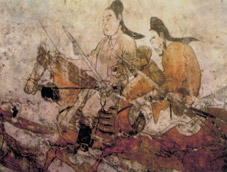
The year 2003 is the 2,500th anniversary of the city of Taiyuan in Shanxi Province. The age-old history of Taiyuan has fostered numerous heroes and men of letters, and has left the city with rich and precious cultural relics. In order to celebrate its anniversary, the city has organized a series of commemoration activities to display its long-standing history and brilliant culture, as well as its great achievements in the fields of politics, economy, and culture since the implementation of the policies of reform and opening-up in 1978.
The city of Taiyuan was called Jinyang and Bingzhou in ancient times. According to historical records, the town of Jinyang was first established in 491 B.C. In 248 B.C., King Zhuang Xiang of the State of Qin established the Taiyuan Prefecture and made Jinyang the prefectural seat. In 617, Li Yuan (565-635), an official in the Sui Dynasty (581-618), placed himself at the head of the uprisings. He founded the Tang Dynasty in 618 and made Chang'an, in present Shaanxi Province, his capital and Taiyuan his northern capital. In 742, Emperor Xuan Zong of the Tang Dynasty (618-907) made Chang'an, Taiyuan, and Luoyang in Henan Province his three capitals. Taiyuan was rebuilt in 979, the fourth year of the reign of Emperor Tai Zong in the Northern Song Dynasty (960-1127). Since the founding of the People's Republic in 1949, Taiyuan, a town of strategic importance in the Yuan (1271-1368), Ming (1368-1644), and Qing (1644-1911) Dynasties, has become one of the important industrial and commercial cities in North China.
The city has 30 historical and cultural sites that are under state and provincial protection. They include the famous Jinci Temple, the Lingxiao Twin Pagodas, one of the masterpieces of ancient Chinese architecture which has been designated the emblem of the city, the Taoist grottoes in Longshan Mountain, and the world-famous Buddhist grottoes in Tianlong Mountain, first built in the Eastern Wei period (534-550). In addition, there are many scenic areas of great potentialities, such as Jinyang Lake, Yunding Mountain, and Jueshan Mountain. Taiyuan has become a major destination in the provincial tourist industry.
Taiyuan enjoys the reputations of the Cradle of the Chinese Drama, the Sea of Folk Songs, and the Town of Folk Dances. Rich in content, art forms, and local traditions, the distinctive village theatrical performances and folk songs and dances of the city, including yangko (a popular rural folk dance), lianhualao (a ballad sung to the rhythm of bamboo clappers), and land boat dances, enjoy great prestige both at home and abroad. Since ancient times, the capital of Shanxi has highly valued the importance of commerce, and it established the Culture of the Jin (Shanxi) Merchants. Emphasizing credibility and honesty, the Jin merchants have succeeded in business for several hundreds of years. In Taiyuan, there are many time-honored stores, such as the Qingheyuan, Liuweizhai, and Shuanghecheng food stores.
The city's cooked wheat food has long been famous in China, especially its noodles of distinctive flavors.
Taiyuan has given birth to many eminent historical personalities, including statesmen, strategists, writers, and artists. Luo Guanzhong (1330-1400), a popular novelist and dramatist in the Yuan and Ming Dynasties, wrote The Romance of the Three Kingdoms, and in order to commemorate him, the Guanzhong Cultural Town was built in Taiyuan's Qingxu County. Fu Shan (1607-1684) was not only an outstanding thinker and great patriot, but also a great master of traditional Chinese painting and calligraphy. In the city proper of Taiyuan, the simple yet elegant Stele Garden of Fu Shan's Calligraphy was built to display his great works.
(China Pictorial September 26, 2003)
|

